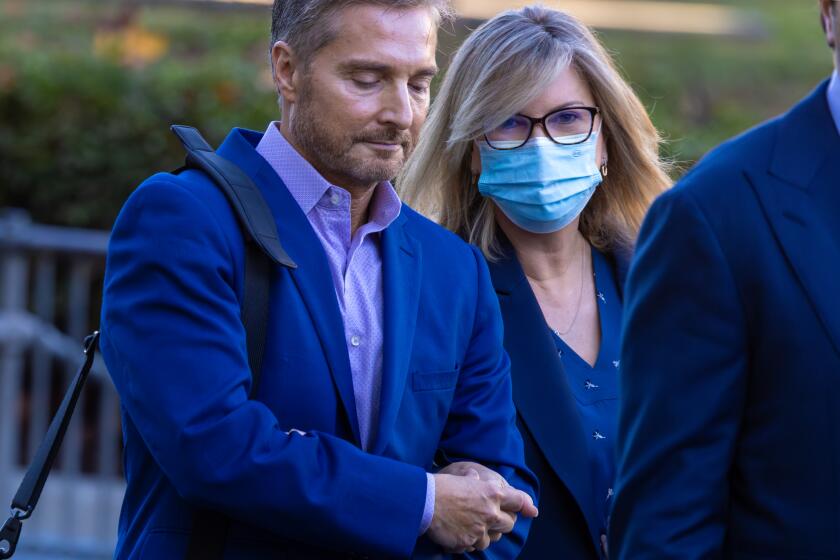A South L.A. teen died after a fight at school. Officials ruled the death an accident. What comes next?

- Share via
The Los Angeles County medical examiner has ruled a 16-year-old girl’s death from blunt force head trauma an accident, raising questions from her family about how thorough and conclusive officials have been with the case.
The girl’s mother has pointed to video from a shocking school fight that showed her daughter, Shaylee Mejia, hitting her head during the melee just days before she died. Her mother, Maria Juarez, blames the high school for failing to protect her daughter, and doesn’t understand how the medical examiner could rule the death an accident.
The determination of the manner and cause of the girl’s death is just one of thousands made by experts each year in Los Angeles County — most of which go without much notice, while others, such as the case of Shaylee, have raised questions about the process.
Juarez told Univision this week that the determination, made last weekend, has left her outraged and disappointed.
“I don’t know why they would call it an accident,” said Luis Carrillo, a civil rights attorney representing Juarez. He said he requested information about how officials came to such a conclusion, but no further details have been shared. He didn’t know if the medical examiner’s investigation included reviewing the cell phone video from the fight.
The deputy medical examiner “should see those videos before she absolutely determines it was an accident,” Carrillo said.
A text message written by Rebecca Grossman, on trial for the murder of two boys killed in a car crash, reveals how she briefly turned her head while driving, distracted by a woman wearing inline skates.
The Times has requested the final autopsy report, but it hasn’t yet been completed. Odey Upko, the chief medical examiner in Los Angeles County, declined to comment on the case pending that final report.
Carrillo and Juarez are now considering obtaining an independent autopsy, Carrillo said.
While finding the manner of death an accident doesn’t automatically close a case, a spokesperson for the Los Angeles Police Department said Friday that the probe into Shaylee’s death has been completed, citing the accidental death determination. He did not cite any further evidence and referred further questions to the medical examiner’s office.
Shaylee Mejia, 16, died days after a fight at Manual Arts High School in South Los Angeles. Her mother says school officials failed to respond to dangerous bullying.
An LAPD spokesperson had previously said Shaylee had fallen before her death, but few other details were provided.
Carrillo said he is still looking into the case with plans to eventually file a lawsuit.
The Times spoke with forensic pathologist experts about what an accidental death ruling means, how such a decision is made and if that determination could eventually change.
What is a ‘manner of death’?
The manner of death is one of the two major determinations made following an autopsy, along with the cause of death.
“The manner of death is about the circumstances,” Upko said. This is a determination for how an injury or disease led to someone’s death.
There are five possible conclusions for the manner of death:
- Natural: when a medical issue causes a death, such as a disease, heart attack or pneumonia.
- Suicide: when someone takes their own life in an intentional act of self-harm.
- Homicide: when the death is the result of another individual, such as from a shooting, stabbing or fight.
- Accident: when a death is caused by something unnatural but was also unintentional. This can be a car crash, an overdose or a deadly fall.
- Undetermined: if an investigator cannot find enough evidence to substantiate a determination, this will be the finding. This is rarely used by medical examiners, experts said.
A text message written by Rebecca Grossman, on trial for the murder of two boys killed in a car crash, reveals how she briefly turned her head while driving, distracted by a woman wearing inline skates.
This determination is made after the body is examined in an autopsy and an additional investigation is done, said Iain M. McIntyre, a forensic toxicologist consultant who previously worked for almost 20 years at the San Diego County Medical Examiner’s office.
“Often times the manner of death is not obvious even after the autopsy,” McIntyre said.
How is that different from cause of death?
“The cause of death is most often the medical reason why the person died, ...or what actually is responsible for the death,” McIntyre said. This is usually quite clear from the autopsy, he said, unlike the manner of death, which often takes more time.
“The manner of death can take a while if the circumstance is not very clear,” Upko said.
While there are only five options for the manner of death, there are many options for the cause of death — often with multiple reasons contributing to a death.
How do forensic pathologists make such a decision?
“Once you determine the cause of death, that’s the first step, then manner of death is the second step,” Ukpo said.
McIntyre said the medical examiner will consider everything available.
“Hospital records, police reports, reports from their own investigators, toxicology, histology reports,” McIntyre said, “and obviously autopsy findings.”
Medical examiners do their own independent investigation to determine the manner of death, but Upko said investigators can also consider police reports or other investigative information.
“Ideally, what we’re supposed to do is independently investigate and look at the body on our own,” Upko said. But, he said “we can gather information from [a law enforcement] investigation as well.”
Cases in which an injury led to a death can make determining the manner of death challenging, the experts said, especially when trying to distinguish between an accident or a homicide.
“You can’t make a determination just from the physical injury,” McIntyre said.
McIntyre and Upko both said a manner-of-death determination can change if new information later becomes available.
Upko said videos can also be relevant to such an investigation, but he called that very rare. He declined to say whether investigators reviewed video in Shaylee’s probe.
How is that determination used?
Both experts said it’s important to understand that the manner of death is a medical determination, not a legal one. So law enforcement and prosecutors can use the medical examiner’s findings in their cases, but that doesn’t determine what happens in the criminal justice system.
“The legal system works differently,” McIntyre said. For example, the manner of death could be ruled a homicide, but it may not be a crime — such as in cases of self defense.
There are also ways an accidental death could result in someone being held criminally responsible or liable in civil court, such as an overdose death in which officials prosecute the drug dealer.
More to Read
Sign up for Essential California
The most important California stories and recommendations in your inbox every morning.
You may occasionally receive promotional content from the Los Angeles Times.
















